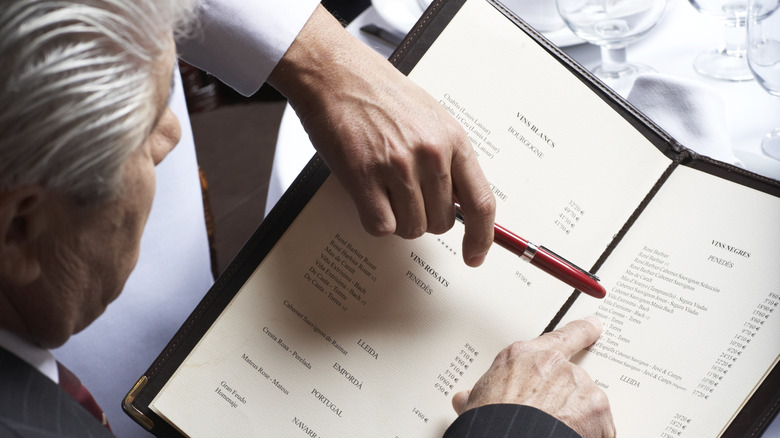Here's What Bracketing Means At A Restaurant (And How It Costs You Money)
Chefs may develop the dishes, but they'll leave the menu engineering to a marketing wiz. To the average customer, a menu probably looks like nothing more than a well-designed list of what's for lunch, but months (or even years) of research and planning are often put into that one seemingly innocuous piece of paper. Restaurant menus first draw us in with bold fonts and bright borders, and then often manipulate us into spending more than we intended, largely with a deceptively simple menu technique known as bracketing. This ploy tricks our brains by offering several similar items at a range of price points.
Let's say you planned on getting a quick glass of happy hour wine, but after perusing the menu you see that for only $4 more, you can get a pricier pour — and that has to be better than the cheapest option, right? The assumption is that with a higher price comes higher quality, but that's not always even the case. With a third more expensive glass on the list, the mid-tier option starts to look like the most sensible choice. That decision might have felt like a win, but you were actually just a victim of bracketing, a classic menu trick designed to get you to order more expensive items. While the range of costs may come off as friendly suggestions, it's a calculated offering designed to reel patrons in and then mess with their price perception, pulling a subtle bait and switch.
Servers are inclined to upsell to their customers, but the menu gets a head start on influencing them
Bracketing plays on the psychological concept of anchoring bias, the idea that people place a lot of weight on the first piece of information they're presented with, i.e. the anchor. Marketers and menu designers use this to their advantage by grouping like items together at varying prices in hopes of the customer gravitating toward the mid-range or priciest option rather than the cheapest. A few more dollars here and there doesn't seem like much, but it adds up quickly. There's nothing necessarily taboo about this technique, but it's a little shady. It's one thing for servers to politely upsell, but diners should have a say in the matter. Still, we can't really bash restaurant owners and servers for doing whatever they can to impress guests and bring money in, aka the emphasis of their job.
But we can take our time reading menus and avoid falling victim to subtle restaurant trickery that fools us into overspending. Aside from the basics like two for one deals and daily specials, restaurants use dozens of well-known psychological tricks to nudge patrons toward spending more. A 2009 study published in the International Journal of Hospitality Management (via Cornell Hospitality Report) found that dollar signs listed anywhere on a menu is a big deterrent to customers. Apparently, patrons are happy to spend money on an evening out, but they don't want to be inadvertently reminded of it. Diners proved to spend more money when prices were listed without a dollar sign leading the price. Let's not forget, menu engineering is a real game of strategy — and restaurant menus are still evolving.

